

Kreuzfahrer-Herrscher. Vassals of the Kingdom of Jerusalem. William of Montferrat, Count of Jaffa and Ascalon. William of Montferrat (early 1140s – 1177), also called William Longsword (modern Italian Guglielmo Lungaspada; original Occitan Guilhem Longa-Espia), was the Count of Jaffa and Ascalon, the eldest son of William V, Marquess of Montferrat and Judith of Babenberg.
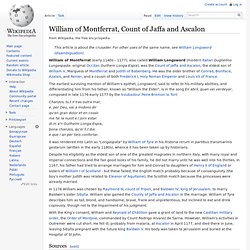
He was the older brother of Conrad, Boniface, Azalaïs, and Renier, and a cousin of both Frederick I, Holy Roman Emperor and Louis VII of France. The earliest surviving mention of William's epithet, Longsword, said to refer to his military abilities, and differentiating him from his father, known as "William the Elder", is in the song En abril, quan vei verdeyar, composed in late 1176-early 1177 by the troubadour Peire Bremon lo Tort: Chanzos, tu.t n'iras outra mar, e, per Deu, vai a midons dir qu'en gran dolor et en cossir me fai la nuoit e.l jorn estar. di.m a'n Guilhelm Longa-Espia, bona chanzos, qu'el li.t dia e que i an per lieis confortar. Haberstumpf, Walter. Dinastie europee nel Mediterraneo orientale. Philip of Milly. Coat of arms of Philip of Milly Philip of Milly (c. 1120 – April 3, 1171), also known as Philip of Nablus, was a baron in the Kingdom of Jerusalem and the seventh Grand Master of the Knights Templar.
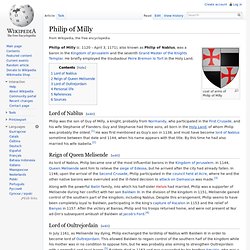
He briefly employed the troubadour Peire Bremon lo Tort in the Holy Land. Lord of Nablus[edit] Philip was the son of Guy of Milly, a knight, probably from Normandy, who participated in the First Crusade, and his wife Stephanie of Flanders. Guy and Stephanie had three sons, all born in the Holy Land, of whom Philip was probably the oldest.[1] He was first mentioned as Guy's son in 1138, and must have become lord of Nablus sometime between that date and 1144, when his name appears with that title. Reign of Queen Melisende[edit] Along with the powerful Ibelin family, into which his half-sister Helvis had married, Philip was a supporter of Melisende during her conflict with her son Baldwin III. Lord of Oultrejordain[edit] Philip joined Amalric's invasion of Egypt in 1167. Personal life[edit] Bohemond IV of Antioch.
Bohemond IV ruled over Antioch and Tripoli (green), and was in conflict with Cilician Armenia (blue).
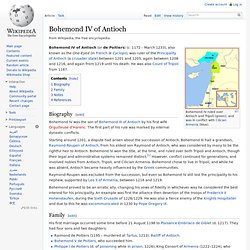
Bohemond IV of Antioch (or de Poitiers) (c. 1172 – March 1233), also known as the One-Eyed (in French le Cyclops), was ruler of the Principality of Antioch (a crusader state) between 1201 and 1205, again between 1208 and 1216, and again from 1219 until his death. He was also Count of Tripoli from 1187. Biography[edit] Bohemond III of Antioch. A coin of Bohemond III.
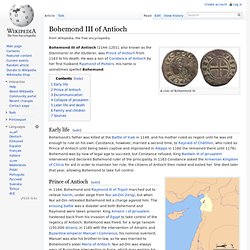
Bohemond III of Antioch (1144–1201), also known as the Stammerer or the Stutterer, was Prince of Antioch from 1163 to his death. He was a son of Constance of Antioch by her first husband Raymond of Poitiers. Constance of Antioch. The Crusader States during the early years of Constance's life.
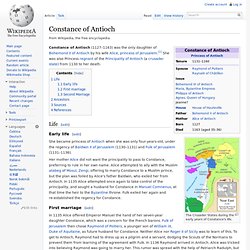
Constance of Antioch (1127–1163) was the only daughter of Bohemond II of Antioch by his wife Alice, princess of Jerusalem.[1] She was also Princess regnant of the Principality of Antioch (a crusader state) from 1130 to her death. Life[edit] Early life[edit] She became princess of Antioch when she was only four-years-old, under the regency of Baldwin II of Jerusalem (1130–1131) and Fulk of Jerusalem (1131–1136). Bohemond II of Antioch. Bohemond II (1108–1130[1]) was the Prince of Taranto and Prince of Antioch from 1111.
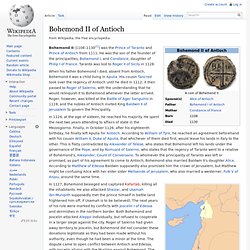
He was the son of the founder of the principalities, Bohemond I, and Constance, daughter of Philip I of France. Taranto was lost to Roger II of Sicily in 1128. When his father Bohemond I died, absent from Antioch, Bohemond II was a child living in Apulia. Bohemond I of Antioch. Bohemond I (also spelled Bohemund or Boamund) (c. 1058 – 3 March 1111), Prince of Taranto and Prince of Antioch,[1] was one of the leaders of the First Crusade.
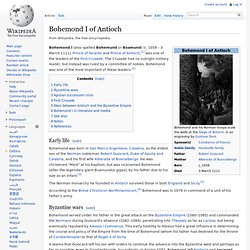
The Crusade had no outright military leader, but instead was ruled by a committee of nobles. Bohemond was one of the most important of these leaders.[2] Amalric I of Jerusalem. Amalric of Jerusalem (also Amaury) (1136 – 11 July 1174) was King of Jerusalem 1163–1174, and Count of Jaffa and Ascalon before his accession.
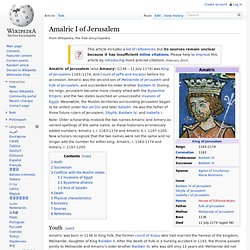
Amalric was the second son of Melisende of Jerusalem and Fulk of Jerusalem, and succeeded his older brother Baldwin III. During his reign, Jerusalem became more closely allied with the Byzantine Empire, and the two states launched an unsuccessful invasion of Egypt. Meanwhile, the Muslim territories surrounding Jerusalem began to be united under Nur ad-Din and later Saladin. He was the father of three future rulers of Jerusalem, Sibylla, Baldwin IV, and Isabella I. Baldwin III of Jerusalem. Baldwin III (1130 – 10 February 1162 or 1163) was king of Jerusalem from 1143 to 1162 or 1163.
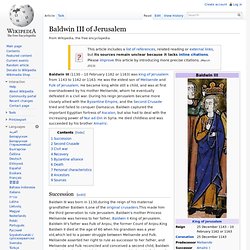
He was the eldest son of Melisende and Fulk of Jerusalem. He became king while still a child, and was at first overshadowed by his mother Melisende, whom he eventually defeated in a civil war. During his reign Jerusalem became more closely allied with the Byzantine Empire, and the Second Crusade tried and failed to conquer Damascus. Baldwin captured the important Egyptian fortress of Ascalon, but also had to deal with the increasing power of Nur ad-Din in Syria. Fulk, King of Jerusalem. The Kingdom of Jerusalem and the other Crusader states in 1135 AD, during the reign of Fulk.
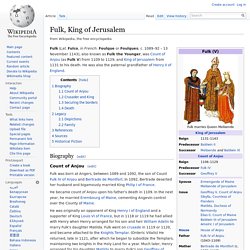
Fulk (Lat. Fulco, in French: Foulque or Foulques; c. 1089–92 – 13 November 1143), also known as Fulk the Younger, was Count of Anjou (as Fulk V) from 1109 to 1129, and King of Jerusalem from 1131 to his death. He was also the paternal grandfather of Henry II of England. Biography[edit] Melisende, Queen of Jerusalem. Crown Princess[edit] Jerusalem had recently been conquered by Christian Franks in 1099 during the First Crusade, and Melisende's paternal family originally came from the County of Rethel in France. Her father Baldwin was a crusader knight who carved out the Crusader State of Edessa and married Morphia, daughter of the Armenian Prince Gabriel of Melitene, in a diplomatic marriage to fortify alliances in the region.[1][2] Melisende grew up in Edessa until she was 13, when her father was elected as the King of Jerusalem as successor of his cousin Baldwin I.
Baldwin II of Jerusalem. Baldwin I of Jerusalem. Baldwin I of Jerusalem, formerly Baldwin I of Edessa, born Baldwin of Boulogne (French: Baudouin de Boulogne), 1058? [1] – 2 April 1118, was one of the leaders of the First Crusade, who became the first Count of Edessa and then the second ruler and first titled King of Jerusalem. He was the brother of Godfrey of Bouillon, who was the first ruler of the crusader state of Jerusalem, although Godfrey refused the title of 'king' which Baldwin accepted. Early life[edit] Baldwin was a son of Eustace II, Count of Boulogne and Ida of Lorraine (daughter of Godfrey III, Duke of Lower Lorraine), and the younger brother of Eustace III, Count of Boulogne and Godfrey of Bouillon. As the youngest brother, Baldwin was originally intended for a career in the church, but he had given this up around 1080; according to William of Tyre, who lived later in the 12th century and did not know Baldwin personally: "in his youth, Baldwin was well nurtured in the liberal studies.
First Crusade[edit] Orte. Crusader states. The Near East in 1135, with the Crusader states marked with red crosses. Asia Minor and the Crusader states, c. 1140 The Crusader states were a number of mostly 12th- and 13th-century feudal states created by Western European crusaders in Asia Minor, Greece and the Holy Land, and during the Northern Crusades in the eastern Baltic area.
The name also refers to other territorial gains (often small and short-lived) made by medieval Christendom against Muslim and pagan adversaries. Background[edit] Beginning in the 7th century, Muslim rulers began expanding their territories into Christian Roman/Byzantine lands conquering Egypt and the Levant and gradually taking over all of North Africa, much of Southwest Asia, and most of the Iberian Peninsula. Principality of Antioch. Kingdom of Jerusalem. County of Edessa. تاريخ سوريا. Personen. Herrscher der seldschuken. Atabegs. Burid dynasty. The Burid dynasty was a Turkish dynasty[1] which ruled over Damascus in the early 12th century. The first Burid ruler, Toghtekin,[2] began as a servant to the Seljuk ruler of Damascus, Duqaq. Following Duqaq's death in 1104, he seized the city for himself. The Burids gained recognition from the caliphate in return for considerable gifts. In return, the caliphate did not interfere in the emirate.[3] They ruled the city until 1154, when it was taken by the Zengid ruler of Aleppo, Nur ed-Din.[4] Burid Emirs of Damascus[edit] Green shaded row signifies regency of Mu'in ad-Din Unur.
See also[edit] Mujir ad-Din Abaq. Mu'in ad-Din Unur. Taj al-Muluk Buri. Toghtekin. Yaghi-Siyan. Yaghi-Siyan (died June 3, 1098) was the governor of Antioch during the First Crusade. He was a Turkic slave of the Seljuk sultan Malik Shah I, who had captured Antioch in 1085 and appointed Yaghi-Siyan governor around 1090. Fakhr al-Mulk Radwan. Duqaq. Zengid dynasty. Nur ad-Din, atabeg of Aleppo. Imad ad-Din Zengi. Aq Sunqur al-Hajib. Tutush I. Artuqids. Ilghazi. Abaaq al-Khwarazmi. Wazire und Walis. Nizam al-Mulk. Ahmad Sanjar. Muhammad I (Seljuq sultan) Malik-Shah II. Barkiyaruq. Mahmud I of Great Seljuq. Malik-Shah I.
Alp Arslan. Chaghri Beg. Tughril. Seljuk. Kilij Arslan II. Mesud I. Malik Shah (Rûm) Kilij Arslan I. Suleiman ibn Qutulmish. Qutalmish. John Tzelepes Komnenos. Kalifen der Abbasiden. Al-Mustanjid. Al-Muqtafi. Al-Rashid (12th century) Al-Mustarshid. Al-Mustazhir. List of Byzantine emperors. Manuel I Komnenos. John II Komnenos. Alexios I Komnenos. AIMA prophecy.